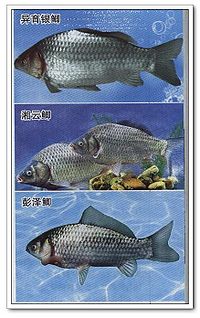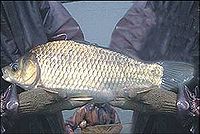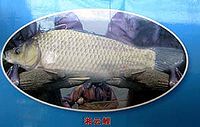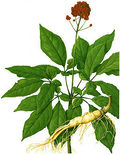鯽魚
| A+醫學百科 >> 藥品百科 >> 中藥百科 >> 鯽魚 | 中藥圖典 |
| 鯽魚 Jì Yú |
|
|---|---|
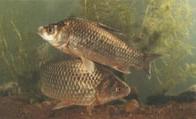 |
|
| 別名 | 鯽、鮒、鰶、鯽瓜子 |
| 功效作用 | 滋補,利水。主治脾胃虛弱,胃痛嘔吐,水腫,走馬牙疳,牙痛等。 |
| 英文名 | Goldfish |
| 始載於 | 《名醫別錄》 |
| 毒性 | 無毒 |
| 歸經 | 胃經、脾經、大腸經 |
| 藥性 | 平 |
| 藥味 | 甘 |
目錄 |
基本信息
jì yú
鯽魚,又稱鮒魚,鯽瓜子,鯽皮子。肚米魚
鯽魚(鯉科)Carassius auratus
[地方名]草魚板子、喜頭魚、鯽瓜子、鮒魚、鯽拐子、朝魚、刀子魚、鯽殼子、金魚(江蘇金壇)。
[形態特徵]一般體長15~20厘米。體側扁而高,體較厚,腹部圓。頭短小,吻鈍。無須。鰓耙長,鰓絲細長。下咽齒一行,扁片形。鱗片大。側線微彎。背鰭長,外緣較平直。背鰭、臀鰭第3根硬刺較強,後緣有鋸齒。胸鰭末端可達腹鰭起點。尾鰭深叉形。一般體背麵灰黑色,腹面銀灰色,各鰭條灰白色。因生長水域不同,體色深淺有差異。
腹部背部是白黑的,背部是黑的.天敵從水上方往下看,由於黑色的魚背和河底淤泥同色,故難被發現;天敵若從水下方往上看,由於白色魚肚和天顏色差不多,故也難被發現;經常看到有些文章里形容清晨時分「東方泛起了魚肚白」,就是這個道理。屬於保護色。
[產地、產季]全國各地水域常年均有生產,以2~4月份和8~12月份的鯽魚最肥美。鯽魚屬鯉形目、鯉科、鯽屬。江蘇、浙江一帶稱河鯽魚,東北稱鯽瓜子,湖北稱洗頭魚等。鯽魚分布很廣,除西部高原地區外,廣泛分布於全國各地。鯽魚的適應性非常強,不論是深水或淺水、流水或靜水、高溫水(32℃)或低溫水(0℃)均能生存。即使在pH:9的強鹼性水域,鹽度高達4.5%的達里湖,仍然能生長繁殖。
鯽魚的生活習性
鯽魚是雜食性魚,但成魚主要以植物性食料為主。因為植物性飼料在水體中蘊藏豐富,品種每繁多,供採食的面廣。維管束水草的莖,葉,芽和果實是鯽魚愛食之物,在生有菱和藕的高等水生植物的水域,鯽魚最能獲得各種豐富的營養物質。矽藻和一些狀藻類也是鯽魚的食物,小蝦,蚯蚓,幼螺,昆蟲等它們也很愛吃。
鯽魚採食時間,依季節不同而不同。春季為採食旺季,晝夜均在不斷地採食;夏季採食時間為早,晚和夜間;秋季全天採食;冬季則在中午前後採食。
生活在江河流動水裡的鯽魚,喜歡群集而行。有時順水,有時逆水,到水草豐茂的淺灘,河灣,溝汊,蘆葦叢中尋食,產卵;遇到水流緩慢或靜止不動,具有豐富餌料的場所,它們就暫棲息下來。
生活在湖泊和大型水庫中的鯽魚,也是擇食而居。尤其在較淺的水生植物叢生地,更是它們的集中地,即使到了冬季,它們貪戀草根,多數也不游到無草的深水處過冬。
生活在小型河流和池塘中的鯽魚,它們是遇流即行,無流即止,擇食而居。冬季多潛入水底深處越冬。
鯽魚的種類及區分
經過選育的我國地方優良鯽魚品種
1.高背鯽。高背鯽魚是上世紀70年代中期在雲南滇池及其水系發展起來的一個優勢種群,具有個體大、生長快、繁殖力強等特點。因背脊高聳而得名。個體最大3000克,親水性強,不宜在內地飼養。
2.方正銀鯽。方正銀鯽原產於黑龍江省方正縣雙風水庫,是一個較好的銀鯽品種。方正銀鯽背部為黑灰色,體側和腹部深銀白色,最大個體重1.5千克,一般在0.5~1千克左右。
3.彭澤鯽。彭澤鯽是由江西省水產科技人員選育出的一個優良鯽魚品種,肉味鮮美、含肉率高、營養豐富。體型豐滿,易運輸,易暫養,易上鉤,利於活魚上市,也是一種生產和游釣兼可發展的魚類。
4.淇河鯽。淇河鯽因產於河南省北部一條東西流向的山區性河流淇河而得名。淇河常年不結冰,1—2月份時,水溫仍在10℃以上,淇河河床兩岸水草叢生。優良的生態環境,為淇河鯽的生長、繁殖創造了良好條件。淇河鯽肉嫩味美,據古籍記載,淇河鯽和香稻米、絲蛋一起,是當地的三大貢品。
除上述幾種經濟價值較大的優良鯽魚外,還有江蘇省六合縣的龍池鯽魚,產於內蒙古海拉爾地區的海拉爾銀鯽等等,它們的共同特點是個體大、肉嫩、味美,均深受當地群眾所喜愛。
雜交鯽魚品種
1.異育銀鯽。它是以方正銀鯽為母本,以興國紅鯉為父本,人工交配所得的子代。異育銀鯽比普通鯽魚生長快2~3倍,生活適應能力強,疾病少,成活率高,既能大水面放養,又能池塘養殖,是非常好的人工繁育品種。
2.雜交鯽魚。以方正銀鯽為母本,太湖野鯉為父本「雜交」而獲得的子代。試養表明,它雜交優勢明顯,具有適應性強、生長快、個體大、食性廣、病害少、肉味鮮美等優點,受到生產單位的普遍歡迎。適合於內塘、外盪、河浜以及湖泊圍養,是一種經濟效益和社會效益都較好的養殖新品種。
引進的鯽魚品種
目前,中國引進的外來鯽魚品種只有原產於日本琵琶湖的白鯽,是一種大型鯽魚。白鯽適應性強,能在不良環境條件下生長和繁殖,對溫度、水質變化、低溶氧量等均有較大的忍受力。最大個體在1000克左右。
目前市場上銷售的鯽魚品種較多,如果需要區分野生鯽魚和養殖鯽魚可以參照以下方法:首先,看魚的個體大小。一般養殖的鯽魚上市規格比較大,尤其是選育和雜交的品種,個頭會比較整齊。野生鯽多為大水體捕撈或垂釣而來,個頭大小不齊,而且普遍偏小,住往只有養殖鯽魚的一半大小。其次,看魚的體型。養殖的鯽魚一般背脊隆起,身體較寬,而野生鯽魚身體紡錘型非常明顯,頭較小。再次,可以看魚的體色。養殖的鯽魚體色較淺,側面以銀白色的居多,野生的鯽魚體色發淺黃,體表光亮。
最新鯽魚品種
湘雲鯽、湘雲鯉是由湖南師範大學生命科學院劉筠院士為首的課題組,應用細胞工程技術和有性雜交相結合的方法,經過十多年的潛心研究培育出來的三倍體新型魚類。與其它鯽魚和鯉魚相比,
湘雲鯽、湘雲鯉具有如下優良特性:
性腺不育 湘雲鯽、湘雲鯉為異源三倍體新型魚類,自身不能繁育,可在任何淡水漁業水域進行養殖,不會造成其它鯽、鯉魚品種資源混雜,也不會出現繁殖過量導致商品魚質量的下降。
生長速度快 實踐表明,湘雲鯽生長速度比普通鯽魚品種快3-5倍,當年魚苗最大生長個體可達0.75kg;湘雲鯉的生長速度比普通鯉魚快30%-50%,當年魚苗最大生長個體可達1.7kg。
雜食性,攝食力強,養殖成本低 湘雲鯽、湘雲鯉為雜食性魚類,湘雲鯽兼有濾食浮游生物的特點,比其他鯉、鯽魚品種餌料利用率高,同時由於無生殖腺的發育,因此所攝取的營養全
部用於生長。
成活率高,抗病力強 湘雲鯉夏花魚種成活率在90%以上,冬片魚種成活率可達98%以上。試驗表明,湘雲鯽、湘雲鯉抗病力強,從未發現大規模感染疾病的現象。
耐低溫、低氧 湘雲鯽、湘雲鯉一般不會因為「泛塘」而導致魚苗大量死亡,適宜高密度池塘精養、網箱及稻田養殖等。湘雲鯽、湘雲鯉在水溫10℃以上即可攝食生長,延長了生長期,在北方地區當年也可養成商品魚。
體形美觀、肉質鮮嫩、營養價值高 湘雲鯽、湘雲鯉可食部分高出普通鯽、鯉魚10%-15%,肌間細刺少,肌肉呈味胺基酸含量明顯高於日本白鯽和普通鯽、鯉魚。
經濟價值
為我國重要食用魚類之一。肉質細嫩,肉味甜美,營養價值很高,每百克肉含蛋白質 13克、脂肪 11克,並含有大量的鈣、磷、鐵等礦物質。鯽魚藥用價值極高,其性味甘、平、溫,入胃、腎,具有和中補虛、除濕利水、補虛贏、溫胃進食、補中生氣之功效,尤其是活鯽魚汆湯在通乳方面有其他藥物不可比擬的作用。鯽魚汆冬瓜,鯽魚熬蘿卜,不僅味道鮮美,而且可以祛病益壽。條小的鯽魚可做酥魚。據分析,每100克鯽魚肉含蛋白質13克,脂肪1.1克,糖0.1克,硫胺素6.6毫克,核黃素0.07毫克,尼克酸2.4毫克,鈣54毫克,磷203毫克,鐵2.5毫克。臨床實踐證明,鯽魚肉防治動脈硬化、高血壓和冠心病均有療效。
醫學認為,鯽魚性味甘、溫。能利水消腫、益氣健脾,解毒,下乳。適用於脾胃虛弱,少食乏力,嘔吐或腹瀉;脾虛水腫,小便不利;氣血虛弱,乳汁不通;便血,痔瘡出血,臃腫,潰瘍等。
《本草綱目》載:「合小豆煮汁服,消水腫:炙油塗,主婦人陰疳諸瘡,殺蟲止痛;釀五倍子煅研,治下血;釀茗葉煨服,治消渴;釀胡蒜煨研飲服,治膈氣。」魚類 鯉魚
在寒風蕭蕭、冷氣襲人的冬季,鯽魚肉肥籽多,味尤鮮美,故民間有「冬鯽夏鯰」之說。我國古醫籍《本草經疏》也對鯽魚有極高評價:「諸魚中惟此可常食。」
鯽魚含有豐富的營養成分,如常食,益體補人。它含有蛋白質、脂肪、糖類、無機鹽、維生素A、B族維生素、尼克酸等。據測定,每百克黑鯽魚中,含蛋白質高達20克,僅次於對蝦;含脂肪達7克。
據行家講,鯽魚下鍋前,人們往往忘不了刮鱗摳鰓、剖腹去臟,卻很少有去掉其咽喉齒(位於鰓後咽喉部的牙齒)的,這樣做出的鯽魚尤其是清炖、紅燒時,其湯汁味道就欠佳,且有的泥味較重。故鯽魚下鍋前最好是去掉其咽喉齒。 寒日食鯽魚的方法
鯽魚的養殖
池塘主養鯽魚要獲得高產效益,養殖技術是關鍵,要注意以下幾個方面:
正確分辨魚種優劣
養殖戶在購買鯽魚魚種時,應根據主要鯽魚養殖品種的生物學特徵,正確分辨魚種的偽劣,避免上當受騙蒙受損失。
選好主養品種
目前主養的鯽魚以異育銀鯽、彭澤鯽、湘雲鯽為主,其中又以湘雲鯽生長速度最快,其次為異育銀鯽,最後為彭澤鯽。但彭澤鯽外觀優於其它品種,出口商品鯽仍以彭澤鯽魚為主。
設計好魚种放養密度
為了降低養殖成本,最好自己培育大規格魚種。
1.用池塘培育鯽魚魚種,每畝放養鯽魚夏花0.8—1.2萬尾可以達到養成規格50---60g的目的。
2.進行鯽魚成魚養殖時,魚種平均規格為50—60g時,每畝放養鯽魚魚種1500---1800尾最為理想,養成商品魚規格可達到350---400g。
確定搭配品種
培育大規格鯽魚種不要配搭草魚和鯽魚,而應選擇鰱魚和鱅魚,數量應佔主養鯽魚20%左右,鱅魚則占鰱魚的10%左右。搭配品種的放養時間不宜過早,尤其是過早投入鱅魚對鯽魚馴化的影響更大。
魚種馴化
1.培育魚種階段馴化相對容易。馴化後的魚種在成魚養殖時上浮搶食時間短,便於管理。
2.馴化時在飼料中添加適量添加劑,可以縮短馴化時間,增加鯽魚攝食麵積和數量。
3.密度對馴化的影響。密度大,群體數量大,易於馴化。在密度已確定不能改變時,可以降低池塘水位,相對增大密度,則既要利於馴化又能提高池塘水溫,促進魚生長。
4.搭配鰱、鱅魚種應在主養鯽魚上浮搶食習慣形成之後投放。
5.馴化期的水質宜「清瘦」不宜「濁肥」。
6.馴化時管理人員需要耐心認真。
飼料粒徑和投飼率
1.鯽魚飼料粒徑的選擇標準「就小不就大」。一般鯽魚規格在10g/尾以下時,飼料粒徑選0.5mm;lO---30g/尾時選1.5mm;75—100g/尾時選2.0mm;150--300g/尾時選2.4mm;300g每尾以上時選3.2mm。
2.魚的攝食能力受到魚的規格及池塘水溫的直接影響,故投飼率應根據實際情況隨機調整,而不應該一成不變。
魚病防治
鯽魚的抗病能力雖強,但近年來仍發現了鯽魚出血性錨頭鰠病,雖然此病的發生率不高,但一旦染上任其發展,也會導致鯽魚大量死亡。嚴重患病鯽魚主要表現為:浮水慢游(乏力)、色澤淡白;魚體表的腹部、背脊兩側(細鱗部位)可見針狀蟲體寄生;蟲體著生處有綠豆或豌豆大小的充血紅斑,病灶部位鱗片鬆動或脫落,粘液增多,少數形成明顯的潰瘍。病原體為鯉錨頭鰠。主要病因:一是清塘不徹底或不清塘,病因待機孳生;二是投入時體表受損傷(或生產操作不慎致使魚體表受傷)的魚種,為病原體寄生創造了可乘之機。
預防方法:①在鯽魚種下塘前1—2天用2.5%敵百蟲粉劑全池潑灑,使池水呈lppm。②小面積主養池,可在發病季節每半月全池潑灑90%晶體敵百蟲0.3ppm,大面積鯽魚混養池,可在鯽魚生長季節,在食場周圍進行敵百蟲掛簍(袋),每月—2次,每次連掛2天。治療方法:在養殖中,出現患病徵兆時,及時觀察檢查,確診後一次性全池潑灑0.5ppm90%晶體敵百蟲、0.2ppm硫酸亞鐵合劑。對於繼發性鯽錨頭鰠病(或已多次使用敵百蟲的池塘),可改用農用敵殺死全池潑灑,用量為每畝水深1m用6一lOmL。
泌尿系統
鯽魚泌尿器官是腎臟,腎臟是1條長的紫紅色條狀物,位於腹腔的背部,屬於中腎,在排泄廢物方面,中腎的主要功能就是形成尿液。血液中溶解的代謝產物、水和營養物質等,經過腎臟內腎小球過濾,其中的水分和營養物質(如葡萄糖、胺基酸,以及鈉、鈣、鎂、氯電漿)大部分回到血液中去,剩下的濾液和多餘的有害物質形成尿液,由輸尿管排除體外。
鯽魚解剖方法
從鯽魚的排泄孔入刀,剪開鯽魚至鰓蓋下面,把鯽魚側放,用鑷子提起左面身體,從排泄孔開口向背面剪,沿脊柱下放剪到鰓後再剪到胸鰭前,把剪下來的左側軀幹去走,再剪掉腮骨,再觀察鯽魚的內部結構
注意:用剪刀時剪刀口向上挑起
營養價值
營養分析
1.鯽魚所含的蛋白質質優、齊全、易於消化吸收,是肝腎疾病,心腦血管疾病患者的良好蛋白質來源,常食可增強抗病能力,肝炎、腎炎、高血壓、心臟病,慢性支氣管炎等疾病患者可經常食用;
2.鯽魚有健脾利濕,和中開胃,活血通絡、溫中下氣之功效,對脾胃虛弱、水腫、潰瘍、氣管炎、哮喘、糖尿病有很好的滋補食療作用;產後婦女炖食鯽魚湯,可補虛通乳;
3.鯽魚肉嫩味鮮,可做粥、做湯、做菜、做小吃等。尤其適於做湯,鯽魚湯不但味香湯鮮,而且具有較強的滋補作用,非常適合中老年人和病後虛弱者食用,也特別適合產婦食用。
相關人群
一般人群均可食用
1.適宜慢性腎炎水腫,肝硬化腹水,營養不良性浮腫之人食用;適宜孕婦產後乳汁缺少之人食用;適宜脾胃虛弱,飲食不香之人食用;適宜小兒麻疹初期,或麻疹透發不快者食用;適宜痔瘡出血,慢性久痢者食用;
食物相剋
鯽魚不宜和大蒜、砂糖、芥菜、沙參、蜂蜜、豬肝、雞肉、野雞肉、鹿肉,以及中藥麥冬、厚朴一同食用。吃魚前後忌喝茶。
每100克鯽魚所含營養素如下
.熱量 (108.00千卡)
.蛋白質 (17.10克)
.脂肪 (2.70克)
.碳水化合物 (3.80克)
.膽固醇 (130.00毫克)
.維生素A (17.00微克)
.硫胺素 (0.04毫克)
.核黃素 (0.09毫克)
.尼克酸 (2.50毫克)
.維生素E (0.68毫克)
.鈣 (79.00毫克)
.磷 (193.00毫克)
.鉀 (290.00毫克)
.鈉 (41.20毫克)
.鎂 (41.00毫克)
.鐵 (1.30毫克)
.鋅 (1.94毫克)
.硒 (14.31微克)
.銅 (0.08毫克)
.錳 (0.06毫克)
食療作用
鯽魚味甘、性平,入脾、胃、大腸經;具有健脾、開胃、益氣、利水、通乳、除濕之功效。
宜:慢性腎炎水腫,肝硬化腹水,營養不良性浮腫者宜食;孕婦產後乳汁缺少者宜食;脾胃虛弱,飲食不香者宜食;
小兒麻疹初期,或麻疹透發不快者宜食;痔瘡出血,慢性久痢者宜食。
忌:鯽魚補虛,諸無所忌。但感冒發熱期間不宜多吃。
食療價值
簡述
鯉科動物鯽魚的肉。鯽魚又稱鮒魚、喜頭、童子鯽。我國除西部高原外,各地江河湖塘等均有分布。獲得後,去鰓、鱗、內臟,洗淨鮮用。
[性能]味甘,性微溫。能補脾開胃,利水除濕。
[參考]含蛋白質、脂肪、維生素A、B1、B2、B12和煙酸、鈣、磷、鐵等成分。
[用途]用於脾胃虛弱,少食乏力,嘔吐或腹瀉;脾虛水腫,小便不利;氣血虛弱,乳汁減少;便血,痔瘡出血。
[用法]煎湯,煨食,蒸熟,入菜肴。
附方
1,鯽魚溫中羹:大鯽魚1尾;草豆寇6g,研末,撒入魚肚肉,用線扎定,再加生薑10g,陳皮10g,胡椒0.5g,用水煮熟食。亦可酌加適量食鹽。
源於《吉林中草藥》。本方用鯽魚重在補脾開胃,所加諸藥均屬溫中健胃之品,且能調味,故有良好的補脾溫中、健胃進食之功。用於脾胃虛寒,食欲不振,飲食不化,虛弱無力等。
2,煨鯽魚:鯽魚1尾,不去鱗、鰓,腹下作一孔,去內臟,裝入白礬2g,用草紙或荷葉包裹,以線扎定,放火灰中煨至香熟。取出,隨意食之,亦可蘸油鹽調味食。
源於《百選方》。本方取鯽魚健脾養胃,用白礬收斂固澀。用於久瀉久痢,不思飲食,脾胃虛弱,大便不固的病人;痔瘡便血而無濕熱者亦可食用。
3,鯽魚赤小豆湯:鯽魚3尾,商陸10g,赤小豆50g,一併填入魚腹,扎定,用水煮至爛熟。去渣,食豆飲湯。
源於《肘後方》。本方取鯽魚、赤小豆補脾利濕,商陸攻逐水飲。用於水腫而脾虛者,可收到補脾及利水消腫之功。
4,千金鯽魚湯:鯽魚250g,豬脂100g,切塊,漏蘆30g,鐘乳石15g。用水和米酒各半共煮至爛熟,去渣取汁,時時飲服,令藥力相接。
源於《千金藥方》。漏蘆、鐘乳石均能下乳汁,常相配伍。本方配入鯽魚更能補氣生血、催乳。用於產後氣血不足,乳汁減少。
烹飪指導
1. 鯽魚紅燒、干燒、清蒸、汆湯、均可,但以汆湯,最為普遍;
2. 冬令時節食之最佳;鯽魚與豆腐搭配炖湯營養最佳;
3. 如用陳皮和鯽魚煮湯,有溫中散寒、補脾開胃的功效,適宜胃寒腹痛、食欲不振、消化不良、虛弱無力等;
4. 巧去魚腥味:
將魚去鱗剖腹洗淨後,放入盆中倒一些黃酒,就能除去魚的腥味,並能使魚滋味鮮美;
鮮魚剖開洗淨,在牛奶中泡一會兒既可除腥,又能增加鮮味;
吃過魚後,口裡有味時,嚼上三五片茶葉,立刻口氣清新。
其他相關
鯽魚為淡水內河魚,《呂氏春秋》云:魚之美者,有洞庭之鮒。觀此則鯽魚為佳品,自古尚矣。
《唐本草》:合蓴作羹,主胃弱不下食。
《本草經疏》:鯽魚調 味充腸,與病無礙,諸魚中惟此可常食。
《本草圖經》:鯽魚,性溫 無毒,諸魚中最可食。
《醫林纂要》:鯽魚性和緩,能行水而不燥, 能補脾而不清,所以可貴耳。
張鼎:和蒜食少熱,同砂糖食生疳蟲,同芥菜食成腫疾.同豬 肝雞肉雄肉鹿肉猴肉食生癰疽,同麥門冬食害人。
《本經逢原》: 鯽魚,有反厚朴之戒,以厚朴泄胃氣,鯽魚益胃氣。
《隨息居飲食 譜》:外感邪盛時勿食,嫌其補也,余無所忌。《飲食須知》:鯽魚 子忌同豬肝食。
參看
|
||||||||||||||||||||||||||||
| 關於「鯽魚」的留言: | |
鯽魚-糖尿病--Liao200707 2014年1月10日 (五) 12:41 (CST) 留言: 台灣學術研究單位:中山醫學大學 國科會 中山醫學大學經實驗證實,鯽魚與天然藥用植物山藥,地黃,枸杞提取物能延緩糖尿病胰島β細胞的惡化,經4周,8周,16周的觀察發現,鯽魚提取物有效提升體內抗氧化環境,使血糖下降情形有增多趨勢,有助於穩定血糖。試驗觀察中更發現,鯽魚水萃物有效改善糖尿病併發症發生。 給鯽魚條目的留言--Liao200707 2014年1月14日 (二) 15:24 (CST) 留言: 2014年1月8日SCI國際醫學期刊Hindawi發表了中山醫學大學採用鯽魚復方在治療糖尿病的創新成果 Research Article Antidiabetic Effects of Carassius auratus Complex Formula in High Fat Diet Combined Streptozotocin-Induced Diabetic Mice 1.Medical Center of Aging Research, China Medical University Hospital, No. 91, Hsueh-Shih Road, Taichung 40402, Taiwan 2.School of Nutrition, Chung Shan Medical University, No. 110, Sec. 1, Chien Kuo North Road, Taichung, 40201, Taiwan 3.Department of Medical Research, Chung Shan Medical University Hospital, No. 110, Sec. 1, Chien Kuo North Road, Taichung 40201, Taiwan 4.School of Medical Laboratory and Biotechnology, Chung Shan Medical University, No. 110, Sec. 1, Chien Kuo North Road, Taichung 40201, Taiwan Received 24 October 2013; Accepted 13 December 2013; Published 8 January 2014 Academic Editor: Bor-Show Tzang Copyright © 2014 Zhi-Hong Wang et al. This is an open access article distributed under the Creative Commons Attribution License, which permits unrestricted use, distribution, and reproduction in any medium, provided the original work is properly cited. Abstract Carassius auratus complex formula, including Carassius auratus, Rhizoma dioscoreae, Lycium chinense, and Rehmannia glutinosa Libosch, is a combination prescription of traditional Chinese medicine, which has always been used to treat diabetes mellitus in ancient China. In this study, we provided experimental evidence for the use of Carassius auratus complex formula in the treatment of high fat diet combined streptozotocin- (STZ-) induced type 2 diabetes. Carassius auratus complex formula aqueous extract was prepared and the effects of it on blood glucose, serum insulin, adipose tissue weight, oral glucose tolerance test (OGTT), total cholesterol, and triglyceride (TG) levels in mice were measured. Moreover, adiponectin, TG synthesis related gene expressions, and the inhibitory effect of aldose reductase (AR) were performed to evaluate its antidiabetic effects. After the 8-week treatment, blood glucose, insulin levels, and adipose tissue weight were significantly decreased. OGTT and HOMA-IR index showed improved glucose tolerance. It could also lower plasma TG, TC, and liver TG levels. Furthermore, Carassius auratus complex formula could inhibit the activity of AR and restore adiponectin expression in serum. Based on these findings, it is suggested that Carassius auratus complex formula possesses potent anti-diabetic effects on high fat diet combined STZ-induced diabetic mice. 1.Introduction Diabetes mellitus is a chronic metabolic disorder which affects people worldwide. By the year 2030, diabetes mellitus is estimated up to about 5% of the world』s population (i.e., 366 million people) [1]. More than 90% of diabetic patients account for type 2 diabetes [2]. The characteristic of type 2 diabetes is insulin resistance and glucose intolerance. Therefore, a newer strategy in the treatment of type 2 diabetes is to reduce insulin resistance in peripheral tissue and control of blood glucose level. Adiponectin and resistin are two kinds of adipose tissue releasing signals with different functions on the control of insulin sensitivity. Previous studies on adiponectin strongly suggest that lower adiponectin levels play an important role in the development of insulin resistance and metabolism disorder related diseases (such as type 2 diabetes and atherosclerosis) [3–5]. Moreover, more evidence suggests a role of resistin in the etiology of both insulin resistance and type 2 diabetes mellitus [6, 7]. Long-term elevated glucose level in the blood likely leads to a variety of diabetic complications such as neuropathy [8], nephropathy [9], and retinopathy [10]. These are partly caused by an increase of oxidative stress. Furthermore, activation of the polyol pathway via the enzyme aldose reductase (AR), which showed an increased activity during hyperglycemia [11], is responsible for diabetic neuropathy and nephropathy [12, 13]. Thus, AR may act as an important therapeutic target in the control of diabetes [14]. In addition, positive net energy balance, resulting from more energy intake and inefficient action of insulin on peripheral tissues, leads to an accumulation of triglyceride in many tissues. Diacylglycerol acyltransferase (DGAT) catalyzes the final step in the biosynthesis of triacylglycerol from diacylglycerol and fatty acyl-CoA. Moreover, the triglyceride content in the tissues was suggested to be closely correlated to the insulin resistance [15]. Current antidiabetic drugs usually have adverse side effects and ineffectiveness against some long-term diabetic complications [16]. Therefore, discovery and development of novel agents for diabetes are still needed. Plants are recognized as a wonderful source for medicines. It is estimated that 1200 species of plants are used as folk medicines for diabetes [17]. Various pharmacological researches of traditional Chinese medicines (TCMs) have clearly demonstrated their biological properties in the treatment of diabetes, such as antihyperglycemia [18], antioxidantive [19], inhibitory activity of AR [20]. Carassius auratus complex formula is a combination prescription of four ingredients including Carassius auratus, Rhizoma dioscoreae, Lycium chinense and Rehmannia glutinosa Libosch. In previous study, results showed that Rhizoma dioscoreae, Lycium chinene and Rehmannia glutinosa Libosch have potent anti-diabetes effects separately [21–23]. In ancient China, Carassius auratus complex formula has always been used in folk medicine to treat diabetes, but it still lacks of scientific evidence of its clinical applications. Therefore, antidiabetic effects of Carassius auratus complex formula in high fat diet combined STZ-induced type 2 diabetic mice have been investigated in the present study. All of these results could enhance our understanding regarding the applications of Carassius auratus complex formula toward diabetes. Discussion It has well been known that type 2 diabetes is a multiorgan disease characterized by impaired insulin sensitivity and altered lipid metabolism and storage [31]. The most common signs seen in diabetes are hypertriglyceridemia, hypercholesterolemia, and TG accumulation in liver and adipose tissue. It is suggested by some previous studies that excess amount of TG accumulation in adipose tissue leads to obesity, and moreover ectopic storage of TG in nonadipose tissue such as liver is associated with insulin resistance and glucose intolerance [32, 33]. In the present study, our results showed that treatment of diabetic mice with Carassius auratus complex formula reduced insulin resistance as indicated by OGTT and HOMA-IR index and normalized lipid storages in liver and adipose tissue. In addition, we have also observed that serum TG and TC levels were significantly reduced after 8-week treatment, indicating that Carassius auratus complex formula could improve glucose homeostasis and restore abnormal lipid metabolism in type 2 diabetes. As shown in Table 1, the Carassius auratus complex formula is mainly composed of crucian carp, a fish, which may help to act as a good source of protein. Data from an ecologic study suggest that fish intake may play a role in the prevention of type 2 diabetes [34], which is also supported by an animal experiment showing a favorable effect of long-chain omega-3 fatty acids, which are abundant in fish, on insulin resistance [35]. Recent study has indicated that high fish intake was associated with a lower risk of type 2 diabetes in Japanese men [36]. In the present study, our results showed that crucian carp possesses antidiabetic effects and could restore the protein expression of adiponectin, one kind of adipose tissue releasing signals with its function in the control of insulin sensitivity. Together with Rhizoma dioscoreae, Lycium chinene, and Rehmannia glutinosa libosch in formula, it might improve the nutrition status under diabetes condition. Furthermore, previous studies have demonstrated that Rhizoma dioscoreae, Lycium chinene, and Rehmannia glutinosa libosch, respectively, possess anti-insulin resistance, antioxidant, and hypoglycemic activities [21–23]. The evidence cooperatively demonstrated that antidiabetic effects of this formula may be performed by these various components. Although biosynthesis of TG is essential for normal life physiology, excess amount of TG accumulation results in obesity. The most common type of lipid abnormalities in diabetes is triglycerides accumulation in liver and adipose tissue, and thus it increases insulin resistance. In our study, we showed the phenomenon of reduced DGAT genes expressions in liver and adipose tissue after treatment in mice. This could be a strategy for the treatment of type 2 diabetes. In previous study, McTernan et al. [37] found that the gene expression of resistin was upregulated in men who had abdominal obesity, indicating that visceral fat deposition is well association with resistin expression and insulin resistance [38]. In our results, we have observed that Carassius auratus complex formula treatment significantly downregulated resistin expression in parallel with decreased abdominal adiposity and reduced insulin resistance. Some evidence revealed that adiponectin is an adipocyte-specific protein, which plays an important role in energy and glucose metabolism [39], and its reduced circulating level is linked to obesity, insulin resistance, and diabetes [40]. Moreover, Yamauchi et al. [41] suggested that adiponectin could rescue insulin resistance via reducing TG contents in liver and skeletal muscles. In accordance with these studies, our results demonstrated that treatment of diabetic mice with Carassius auratus complex formula improves the insulin resistance and glucose intolerance via restoring and/or enhancing the circulating level of adiponectin. Hyperglycemia is frequently found in type 2 diabetes and is often viewed as a risk factor for diabetic complications [42]. Diabetic patients with chronic hyperglycemia lead to an increase in the activity of AR from 3% to 30% and finally complications happen [43, 44]. In this study, treatment of Carassius auratus complex formula suppressed the increase of AR compared to diabetic group, as a meanwhile decreasing fructosamine level. The fructosamine is an index of intermediate glucose control (one to three weeks) and valuable screening test for diabetes mellitus [45, 46]. Moreover, long-term hyperglycemia results in increased production of reactive oxygen species (ROS) [47]. In this study, treatment of Carassius auratus complex formula reduced serum, liver, and kidney MDA levels, supporting a beneficial effect for type 2 diabetes management. 承認:美國國家衛生院 | |
| 添加留言 | |
